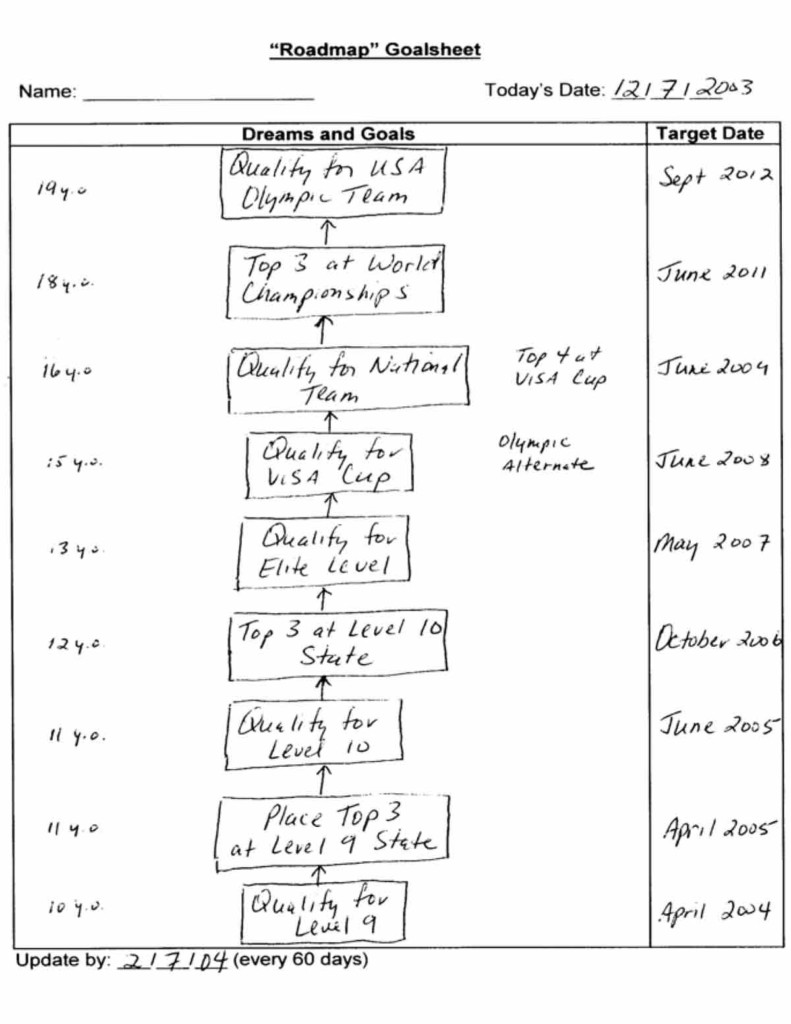So you’re interested in mental toughness. What is it? Are some people just born with it? Am I mentally tough? Is there anything a person can do to improve it? If so, what?
These are all common questions we get from athletes of all sports, coaches, parents, performers, and business people.
The bottom line? Building mental toughness through mental skills training is THE KEY to performing your best and reaching your biggest goals.
…And it can benefit EVERYONE who is willing to put in the work (more on this below).
This quote from Michael Jordan, widely considered the greatest athlete of all time,
sums up the importance nicely:
“The mental part is the hardest part, and I think that’s the part that separates the GOOD players from the GREAT players.”
– Michael Jordan (former NBA basketball player)
Since this is such a common (and important) subject, we decided to create The Ultimate Guide to Mental Toughness. You might be thinking, who are we to take on this task? Mental Training, Inc. was launched in 2006 and is now comprised of dozens of Certified Mental Trainers® working across the US and in 14 countries. Most of us are former professional athletes who have gone back to school to get Masters and Ph.Ds. We’ve made it our life’s work to understand and teach mental toughness. Our most experienced Mental Trainers have collaborated over the past year to make this the most complete mental toughness guide ever created.
This guide was made to answer all your questions about the topic and even teach you the key mental training techniques. These techniques you’re about to learn are the SAME techniques we teach our top performing athletes around the world.
In other words, you’ve come to the right place. Let’s dive in.
Yes – Send me the PDF!
(we promise not to spam you or sell your email address – we hate that too)
OVERVIEW
The mental training industry has done a fantastic job gathering information, but a terrible job of teaching what to do and how. Our goal is to SIMPLIFY this information so you can start your journey towards mental mastery and, in turn, reach your full potential.
This guide lays out ACTIONABLE steps you can implement on your own. Our goal is to offer tremendous value to those interested in learning in mental toughness, whether we ever get to meet them or not. Top athletes work with us because they want a custom program with regular support and accountability, and if and when you ever want such a program we’d be happy to talk. Either way, this guide will provide you with more than enough to get you started and well on your way to becoming mentally tough.
Here’s what we’re going to cover in this Guide:
- What is mental toughness
- Is it important to be mentally tough?
- Common myths
- Who is this for?
- Are you mentally tough?
- How to improve mental toughness
- How to Apply Everything and Become Mentally Tough
- Get help from an expert
First thing’s first – let’s start by defining mental toughness.
WHAT IS MENTAL TOUGHNESS?
We like to define mental toughness in two parts:
- The ability to get in the zone and, as a result, achieve peak performance when it matters most.
- The resilience or grit used to push through adversity and reach success.
The term is most often used in sport, but also applies to business professionals, performers, in education, and life in general.
IS IT IMPORTANT TO BE MENTALLY TOUGH?
As Michael Jordan said, mental toughness is what separates the good from the great. In other words, it’s THE REASON why the world’s top performers become winners.
…And he’s not alone. We’ve studied and worked with top performers around the world and they all say the same thing. Here are a few of the greats across several sports who agree mental toughness is critical to success:
Won the most majors of any golfer in history
“I never hit a shot, not even in practice, without having a very sharp, in-focus picture of it in my head. First I see the ball where I want it to finish, nice and white and sitting up high on the bright green grass. Then the scene quickly changes, and I see the ball going there; its path, trajectory, and shape, even its behavior on landing. Then there is a sort of fade-out, and the next scene shows me making the kind of swing that will turn the previous images into reality.”
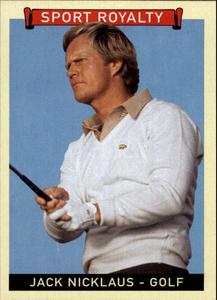
Roger Federer
Won the most Grand Slams of any tennis player in history
“Previously I always thought it was just tactical and technique, but every match has become almost more mental than physical – I try to push myself to move well. I try to push myself not to get upset and stay positive, and that’s what my biggest improvement is over all those years. Under pressure I can see things very clear.”
“Once you find that peace, that place of peace and quiet, harmony and confidence, that’s when you start playing your best.”

Drew Brees
Most passing yards in NFL history
“I visualized what I had to do,” he said. “I read something where this guy was a Vietnam POW. And the way he got through being imprisoned that whole time was to visualize playing on his home golf course. He had never broken 92 on that golf course. He just sat there and visually played it. That’s how he made it through the day. Sure enough, after being released, he goes back home and shoots 82. He visualized it. He saw it. I think that’s what separates some of the great athletes from others. They put themselves in situations and they visualize what they are going to do to have success. They visualize the shot, the throw, the catch, how the defense is going to react. Then when you go out and do it, it’s as if it already happened.

Kobe Bryant
3rd most career points in NBA history
“Mental toughness is really all about not getting too high or too low but kinda staying even keel. The trick is not to get too emotionally attached to the situation.”
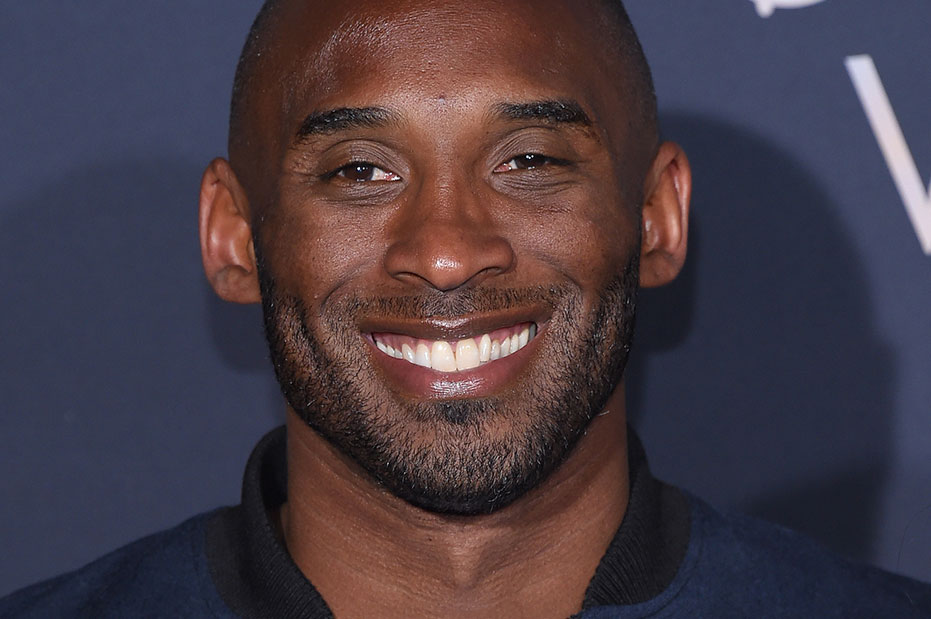
Nastia Liukin
Most gymnastic medals at one Olympic Games
“Visualization was important to me during competition and training. I would set a lot of goals and not just those long-term goals. I’d set weekly and monthly goals. It helps when you have something you’re working to attain on a daily basis instead of going to the gym and working for several hours with no direction.
“I [also] did a lot of visualization when I was hurt. Even if I was injured and wasn’t able to physically do the routine, I could visualize it in my head. It was like muscle memory in my mind and when I would finally heal, I could go back out there with confidence.”
We couldn’t agree more. Mental toughness is the key to achieving your biggest dreams. This is true of ANY sport (and any discipline, for that matter) – sport, performance, business, school, etc.
Take a second to imagine this…
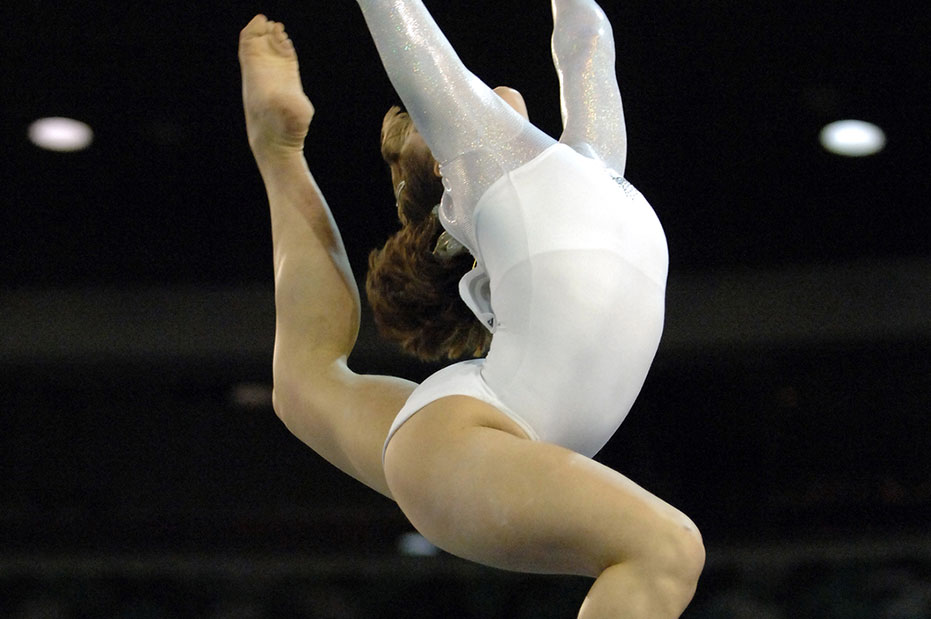
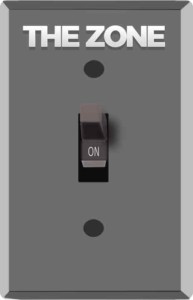 What if you had a toggle switch in your mind you could flip to instantly get in the zone?
What if you had a toggle switch in your mind you could flip to instantly get in the zone?
Let’s say you’re in the middle of an important competition or performance and you start to choke.
The second you start to feel the anxiety creeping in, you just flip the switch.
BOOM – you’re in the zone.
How would that change your life?
In the short term, it would give you the ability to perform your best WHENEVER YOU WANT. That includes times when it matters MOST – a big competition, an important performance, an important sales meeting, etc.
In the long term, mental toughness also gives you the ability to get out of a funk or a slump. It allows a person to have breakthrough moments.
That’s the importance of mental toughness.
This lightswitch effect isn’t achieved overnight, however. It takes consistent practice to be able to control your state of mind at that level. The good news is it’s achievable for anybody willing to put in the work. We’ll dive more into that later in this guide.
COMMON MYTHS
Now that we’ve defined mental toughness and discussed its importance, it’s time to confront the 4 most common myths.
MYTH #1: Mental Toughness Can’t be Taught
False – it absolutely CAN be taught.
Over 70 years of research shows mental toughness can be taught to athletes and people of all ages, experience levels, and personality types – It’s not something you’re just born with.
MYTH #2: Mental Training is Only for Those with Mental Illness
False – It can actually benefit everyone.
Although mental training may sound like it’s a treatment for people with mental illness, there’s actually an important distinction. Mental skills can be used by normally functioning people to become exceptional at what they do. In other words, you don’t have to be sick to get better.
If you have a disorder (ex. ADHD), mental training can definitely still help you. The skills taught have nothing to do with treating disorders, however. That is a separate issue that should be addressed by a therapist.
MYTH #3: It Takes Too Much Time to Learn
False – By using technology and overlapping onto physical practices, everyone can find the time.
In fact, we created MentalAppⓇ to help you weave mental training into your everyday life. We’ll talk more about this later in this guide.
MYTH #4: Physical Toughness = Mental Toughness
False – They’re different. And for optimal performance, you need to work on both at the same time.
Yes, physical toughness matters. So does mental toughness. And yes, it is possible to have one without the other.
Without physical toughness, success in sport would be hard to achieve (even for a mentally tough athlete). At the higher levels of sport however, most athletes are physically fit and have strong physical skills. Mental toughness then is what gives one person the edge over another. It’s what separates good from great.
WHO IS THIS FOR?
As we stated above, mental toughness can be beneficial to everyone willing to put in the work.
Regardless of whether you’re in sport (athletes, coaches, and even parents), business, performance (music, acting, dance), etc., mental toughness can help you achieve your biggest goals and dreams. In fact, it’s THE KEY.
The only people that it can’t help are people who are willing to settle for good enough.
If you are willing to settle for good enough, read no further.
For those who are serious about being great at what they do – being THE BEST at what they do – read on.
ARE YOU MENTALLY TOUGH?
Are you mentally tough enough to achieve your biggest dreams?
Actually, a better question is:
“Are you mentally tough enough…YET?”
As we stated in the first common myth (and it’s worth stating again), mental toughness can very much be LEARNED. Most people don’t have all their mental skills mastered at birth, or by accident. To truly become a master at your craft, you must become a master of your mental skills. And like anything, that takes practice.
This is also true of coaches, parents, and anyone overseeing the performance of someone else. A mentor’s mental toughness trickles down into the person learning. In situations where coaches, parents or other mentors are involved, it’s important for BOTH parties to work on their mental skills so everyone can speak the same mental language.
So what are some common signs a person’s mental skills could use improvement?
Signs Mental Skills Needs Improvement
- Difficulty controlling nerves or anxiety during important competitions or games
- Low confidence
- Angry outbursts
- Giving up too easily or lack of motivation
- Difficulty focusing
- Poor starts or finishes
- Poor support (from a coach, parent, etc.)
- Feeling pressure from another person (from a coach, parent, etc.)
- High expectations due to reputation (and therefore pressure to perform well)
- Competition performance level is lower than practice level
- “Winning is everything” attitude (outcome focused)
- Lack of ability to bounce back from mistakes
- Fear of the competition (fear of failure or what people might think of you)
If any of the above sound familiar, you’re not alone.
To help people figure out where they stand, we’ve created a free online test that over 30,000 people have taken so far.
Mental Toughness Online Test
Take this 20 question test to quickly gauge your mental toughness. Whether you’re a beginner or an expert, it’s good know your strengths & weaknesses..
At the end, the test will show one of the following results to benchmark where you currently stand:
- Struggling
- Surviving
- Thriving
HOW TO IMPROVE MENTAL TOUGHNESS
Even with top athletes like Michael Jordan confirming that mental toughness is critical for success, we’ve found that less than 1% of young athletes train mentally.
Why is that?
Most say they don’t know what to do.
If that’s you, you’re in luck – that’s exactly what we’re about to get into in this section.
The 5 States of Mind to Achieve Mental Toughness
Earlier in this article, we defined mental toughness in two parts. As a quick refresher, the first part of our definition is:
“The ability to get in the zone and, as a result, achieve peak performance when it matters most.”
In order to improve mental toughness, we have to learn how to get in the zone. On purpose.
Before we get into that, let’s first take a moment to clarify exactly what we mean by “getting in the zone.”
We’ve broken it down into 5 simple states of mind known as the “Zone-5™ states”:
- Calm
- Confident
- Carefree
- Focused
- Motivated
In order to get in the zone, you have to achieve ALL 5 of these states of mind at once. We call this getting “high Zone-5™”. The acronym we use to remember these states is CCCFM.
At first, this may sound complicated. It can be tricky initially (like anything), but with practice it’s possible for ANYONE to control these states. Top performers understand how to change their thoughts to get high Zone-5™ almost immediately and in pressure situations.
In the following sections, we’ll go into the mental skills necessary to master each of the Zone-5™ states.
Ready to take control of your own mind?
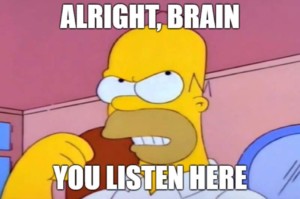
Good. Let’s do this.
The first Zone-5 state we’ll discuss is Motivated.
Motivated
In order to be properly motivated, it’s important to lay out a solid foundation. Just like building a house, the foundation has to be strong or everything will collapse down the line.
Reasons Why
First and foremost, it’s critical to take some time and think about your ‘reasons why’. Why do you do what you do? What’s driving you? Why do you want to achieve your big, aspirational dream?
Take some time to think deeply about this. Then, write them down. When times get tough (they inevitably will), your ‘reasons why’ will keep you going. If your reasons why aren’t genuine and deep, you’re more likely to give up when times get hard.
Goal Setting
Once you have some clear ‘reasons why’ laid out, it’s time to set some goals. Setting goals means writing them down in a list. Start big – what are your biggest aspirations and dreams in your sport, business or life? Once you have an end goal set, break it down into smaller goals that you’ll achieve on the way to the larger goal.
Again, write these down. If you don’t have a clear destination, you’ll be driving aimlessly down the road of life.
Roadmap
After you’ve carefully laid out and written down your goals and reasons why, the next step is to create a roadmap. This roadmap will guide you to your ideal performance zone (by the way, we wrote the book on roadmaps to the zone).
Using the goals (big and small) you set in the step above, add dates you aim to accomplish these goals by. What age do you want to achieve your biggest goal? From there, what sort of timeframe is necessary to achieve your smaller goals? Be realistic while remaining ambitious. Below is an example from one of our gymnasts (who achieved ALL of her goals by the way!)
Once you have the foundation laid out, you’re ready to focus on the the next Zone-5 state: Calm.
Calm
In order to remain calm in times of pressure, we’ve packaged together 3 of the most fundamental skills and call them 3-CoreⓇ.
3-CoreⓇ
The 3-CoreⓇ is a combination of 3 skills that makes up the core of mental toughness training. Here’s a breakdown:
-
-
Progressive relaxation
-
Mindfulness
-
Imagery
-
In order to practice 3-CoreⓇ, you’ll need a comfortable chair in a quiet, distraction-free place.
Let’s break down each component into some more detail.
Progressive Relaxation
Progressive relaxation is an effective way to completely relax your body in just a few minutes. Here’s how to do it:
-
- Set a timer for 2 minutes.
- Sitting in a comfortable chair, close your eyes.
- Focus on the feeling of the air going in and out of your nose. Relax your stomach muscles to draw the air into your lungs (called “belly breathing”).
- Choose a muscle group.
- Inhale slowly and deeply as you tense this muscle as hard as you can for 4 seconds.
- Now, exhale slowly as you relax the muscle for 4 seconds.
- Progress muscle group by muscle group, from your head down to your toes.
- Focus your mind on each muscle group as you do the exercise
- This quiets your mind and allows you to “get in the present” (we’ll explain that next in the Mindfulness section).
Mindfulness
The GAP exercise is what we use to practice mindfulness. It’s a key mental skill – possibly THE key mental skill. The GAP exercise is a simple form of thought awareness that allows you to recognize current thoughts and release them. This is EXTREMELY important in becoming mentally tough because in order to control your thoughts, you have to first become aware of them (become mindful).
Here’s how to do it:
-
- Set a timer for 2 more minutes.
- After completing 2 minutes of progressive relaxation, stay seated in the same chair with your eyes still closed.
- Focus your attention on the feeling of air going in and out of your nose.
- Without even trying, thoughts will probably be passing through your mind (or lingering) – this is completely normal.
- As a thought enters your mind, recognize it.
- Say “got it” as you become aware of what this thought is, and allow the thought to leave.
- Keeping your eyes closed, wait patiently in the “gap” between thoughts for the next thought to come in.
- Don’t worry about what the thoughts are, and don’t try to force them in or out. Just recognize each thought as it enters your mind, and say “got it” to release the thought.
- Do this until the timer sounds.
This exercise is challenging at first because society has taught us that having nothing on our minds is a sign of weakness. In reality, though, having nothing on your mind is an enormous sign of mental strength. In fact, a quiet mind is necessary for the zone to happen. That’s why the GAP exercise is the key to getting in the zone intentionally.
An important part of recognizing thoughts is getting present. Getting present means focusing your attention on the present moment – not the future or the past. This is important because in order to be in control of your thoughts and therefore your actions, your mind has to be focused on the present moment. If you’re focused on the past or the future, you won’t be able to concentrate or get in the zone (more on this later).
Imagery/Visualization
The third mental skill in the 3-CoreⓇ is imagery or visualization. Imagery is the most researched of all the mental skills and has been scientifically proven to improve performance in real life when done correctly. The first thing to do is create a short list of actions you’d like to improve or master for a performance or competition. Once you have that list, follow these steps to perform proper visualization:
-
- After you’ve completed progressive relaxation AND the GAP exercise, set a timer for at least 3 minutes.
- While remaining seated, relaxed and with your eyes closed, imagine one of the actions on your list that you’re aiming to master.
- Imagine yourself executing this action perfectly.
- Imagine it in the first person (out of your own eyes)
- Imagine what it would look like, what it would feel like, and what it would sound like
- Imagine a crowd cheering as you complete it perfectly
- Each time you imagine it, your brain prepares to do it physically
- Repeat until you have the action dialed in your mind.
- You can do this with as many actions as time allows.
- When the timer rings, open your eyes – you’ve just completed 3-CoreⓇ.
3-CoreⓇ is a great way to improve your mental toughness in just 7 minutes per day (2 minutes progressive relaxation, 2 minutes GAP, 3 minutes visualization). As you progress, you may find imagery sessions lasting longer, which is completely ok. Most of our pro and Olympic clients perform imagery sessions that last longer than 3 minutes. In fact, top level athletes do 3-CoreⓇ several times per day.
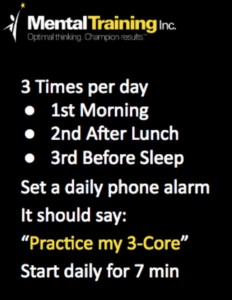
Controllables
Besides 3-CoreⓇ, another great mental skill to help stay calm is to focus on controllables.
In sport, business, performance and life in general, there are many factors we can control, as well as many factors we can’t control. In order to be in your best state of mind, it’s important to deliberately focus on things we have control over.
Harvard psychologist and philosopher William James once said:
“Perception distinguishes reality.”
In other words, what you perceive (or focus on), creates your reality.
The problem though, is most people don’t have control of their own focus. For example, athletes often find themselves worrying about all kinds of uncontrollable things during competition:
-
- Opponents
- The condition of the field/course/court/track
- How much playing time they might get
- How important it is to win
- The weather
- The coach
- Rankings
- What people might think
- Etc.
If we aren’t in control of our focus, we tend to focus on all the wrong things – things we have no control over. This leads to anxiety, decreased confidence and poor performance.
When we are in control of our focus, we can intentionally think about things we do have control over, such as:
-
- Positive thoughts
- Ideal emotions
- Problem solving
- Ideal energy
- Effort
One of the key elements to becoming mentally tough is being able to distinguish controllables from uncontrollables and then focus on what helps performance.
Confident
The next state of mind is confidence. In order to perform your best, it’s important to have confidence. In fact, it’s shown to be the single most important determinant of success. Stanford professor and famous social psychologist Dr. Albert Bandura believes there’s no such thing as too much confidence!
Being overconfident means your FOCUS has gone away from the task. So as long as you’re focused, work to build as much confidence as possible.
Since the more confidence you have the better, you want as many ways to build it as possible. Here are 12:
- Physical repetition
- This is the #1 way to improve confidence!
- Practice strengthens neural pathways
- When you can physically do something without having to think about it in competition, you will have plenty of confidence
- Get a good warmup
- Getting loose and rehearsing what you will do in competition can give you the confidence to stay relaxed and trust your body
- Remember past successes
- Recent good memories can be a powerful tool in improving confidence
- Success journal
- Keeping a written journal of personal accomplishments, complements from experts, and good performances helps create the identity that you are great and can achieve success.
- Visualization
- Research proves that imagining successful behaviors helps increase confidence
- Use first person, use all your senses, repeat often
- Physical posture
- Research shows posture can actually change emotions (it’s not just a reflection of emotions
- Stand up straight, hold your head up high, and behave like a happy and confident person – it actually helps you become one!
- Facial expressions
- Facial expressions have been found to change emotions (they’re not just a reflection of emotions)
- In other words, smile 🙂
- Positive Self-Talk Skills
- The way you talk to yourself affects the way you perform, so be positive!
- Focus on controllables
- Focus your energy on things you have control over:
- Preparation, tactic, effort, thoughts, intensity, technique
- Identify things you can’t control and choose to let those things go
- Weather, opponents, score, field conditions
- Focus your energy on things you have control over:
- Personal highlight video
- Capture video clips from positive past performances
- Assemble them into one video file with your favorite music dubbed over it
- Anxiety reduction
- Reducing nervousness helps you feel more confident
- Focus on the present (rather than the past or future)
- Meditation/ 3-CoreⓇ
- Deep breathing
- Develop positive habits
- Practicing your routine until it feels automatic provides more brain bandwidth to focus adapting to a changing environment
- Great athletes use rituals before and during competition
Focused
The next state of mind is focus. One of the main mental skills to help achieve focus is self-talk.
Self-talk
Self talk is quite simply the way we talk to ourselves. It can be positive or negative, and it can be conscious or subconscious. Either way it’s incredibly powerful, so it’s important to be in control and make your self-talk positive!
We’ve broken self-talk down into 5 skills you can practice:
1) Minimizing
Minimizing is the practice of making each competition or event of equal significance in your mind. It’s common for athletes to choke during important events, so by putting every event on an equal playing field, you’re reducing the likelihood of cracking under pressure.
Whether you’re in the Olympics or a small local event, tell yourself this is just another event. It’s an opportunity to gain more experience, learn from my mistakes, and improve for the next one. Don’t worry about outcome, just think about performing your best like in practice.
2) Matter-of-fact
Being matter-of-fact is an important way to take the emotion out of a high pressure situation. Rather than getting emotional when something happens, describe ONLY the facts – not your interpretation or feeling about what happened. In other words, look at situations at face value and nothing more. Here’s an example:
Let’s say you drop the ball in an important competition. Here are two ways to handle the situation:
Emotional response:
“Arghh! I always drop the ball – why am I so bad?!”
Matter-of-fact response:
“I dropped the ball – it’s on the ground – forget about it and move on.”
The emotional response catastrophizes an insignificant mistake, and will likely lead to a greater string of errors down the line. The matter-of-fact response allows you to stay calm, forget about it, and recover much more quickly and easily.
3) Optimism
It’s important to be optimistic in order to perform well. Optimism is highly correlated to health, success and happiness.
Optimists believe good things happen often and in many situations. By believing good things happen this way in our life, we’ll constantly be looking for good things, and more likely find them!
From a mental toughness standpoint, the best way to be optimistic is to make compliments permanent and criticisms temporary. Here’s an example of a permanent statement vs. a temporary statement:
Permanent statements:
“I scored that point because I’m a good player.”
“I dropped the ball because I’m a bad player.”
Temporary statements:
“I happened to score a point, but it was lucky.”
“Usually I catch the ball, but I happened to drop it that one time.”
In order to optimize your self-talk (and improve your performance) it’s important to make compliments permanent and criticisms temporary. Take responsibility for the good things you do, and let the mistakes go. In fact, forget the mistakes ever happened! The more you remember good performance, talk about it, and start to identify with being a high performer, the more you’ll manifest high performance in the future.
4) Phrasing positively
This is the most published of all the self-talk approaches, so you might think it’s obvious, but most get it wrong. Every time you talk about an action, it’s important to frame that action positively rather than negatively. Here is an example of the same action framed in both a positive and negative way:
Positive: “Catch the ball”
Negative: “Don’t drop the ball”
The brain focuses on the action even if you’re telling yourself not to do that action. In the example above, if you’re self-talk is “don’t drop the ball,” the brain won’t process the “don’t” part. All it will process is “drop the ball.” Now the mind is focused on dropping the ball, and consequently that’s more likely to happen!
If you instead focus on “catch the ball,” the brain processes exactly that – “catch the ball.” Now, your mind is focused on the desired outcome, and that’s more likely to happen.
In short, focus on getting what you want rather than not getting what you don’t want.
Cue words are an extension of positively phrased self talk. Cue words are short phrases that can can help you quickly focus on controllables and trigger Zone-5™ states when used properly. This mental skill is usually most effective when personalized because cue words are usually individual and sport specific.
Here are some general examples to give you an idea:
-
-
- I believe in myself and my talent
- I am strong, confident and prepared
- I belong here
- Show them I’m here to stay – I deserve this
- I can’t wait to show everyone what I’ve been working on
- Perform like I own the place
- This is easy
- Let’s crush ‘em
- Send it
- Keep working
- Keep fighting
-
You can (and should) create your own cue words (or phrases) that resonate better with you. Again, it should be individual and sport specific. Pick something positive that gets you focused on controllables, motivated, in the present, more confident, etc.
5) “As long as I” Statement
The “As long as I” statement is a great way to quickly help get in the zone. Use the following template to draft a statement that’s tailored to your sport or activity:
“As long as I (X, Y, and Z) , I know I’m doing everything I can in the moment, and the outcome will be what it is.”
Replace X, Y and Z with 3 controllables of your choice. Give it some thought and put in 3 things that will empower you when you say this statement in a pressure situation. Usually athletes choose to control EFFORT, STRATEGY and EMOTIONS.
The purpose of this statement is to quickly shift your focus onto items you can control. This quick statement allows you to reduce anxiety and pressure that comes from accidentally focusing on uncontrollables.
Carefree
To become carefree means we temporarily don’t care about the outcome. In sport, this could mean the score. Technically the score is an uncontrollable variable, so focusing on it will often lead to anxiety. What you can control is your technique, your effort, etc. The score is a RESULT of these things, not something you can directly control.
Of course, every athlete cares about the score. But since it’s technically an uncontrollable, it’s important to shift your focus off it (at least temporarily) and onto controllables in order to get the best results.
So how does someone take their focus off the score (an uncontrollable) and instead shift it to something controllable? It can be tough when in high pressure situations when there’s something on the line and emotions are involved.
That’s the next (and final) mental skill we’re going to discuss here. We created a tool called the Emotion WheelⓇ to help you do exactly this.
Emotion WheelⓇ
The Emotion WheelⓇ was designed to get a person carefree, focused on controllables, and in the zone quickly. Here’s an overview:
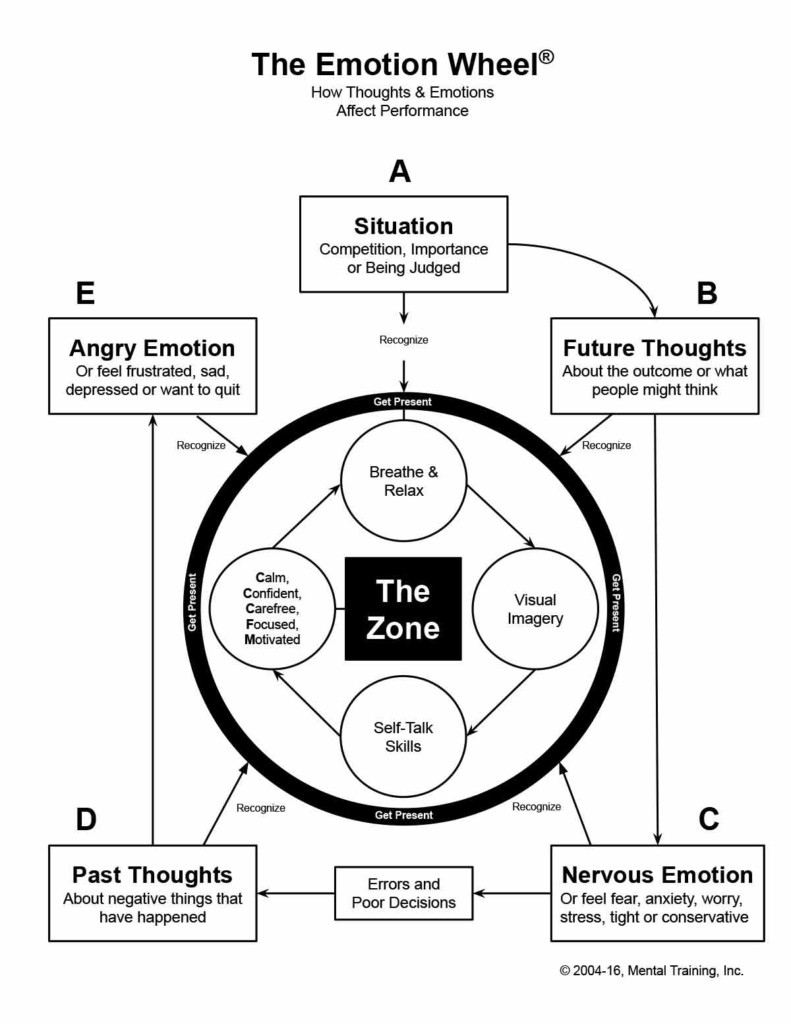
Don’t be overwhelmed – it’s actually simpler than it looks. Think of the Emotion WheelⓇ as basically two rings – an outside ring and an inside ring – with the zone in the middle:
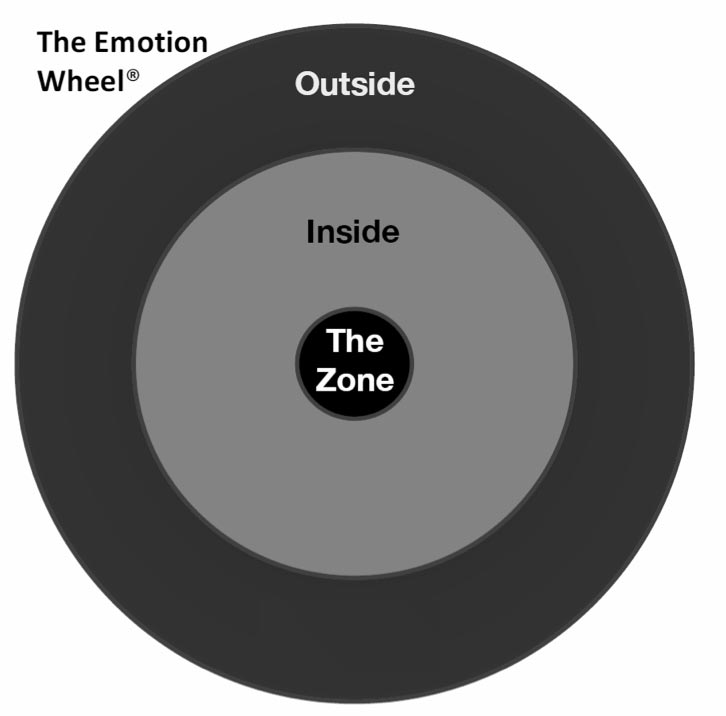
Much simpler, right?
We’ll get into more detail shortly, but for now just know the goal is to get into the INSIDE ring, because that’s where you’ll find the zone.
Let’s first break down the outside ring.
The Outside Ring
The outside ring is where everybody starts, and many get stuck:

Start at point A.
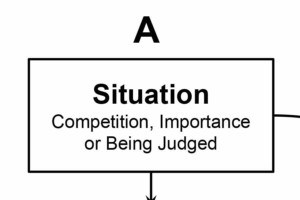
There’s an important situation, such as a competition, and you’re being judged. What tends to happen is, we think about the score or the fact that we’re being judged, and begin to worry about what people might think of our performance. As a result, our thoughts move towards the future – point B.
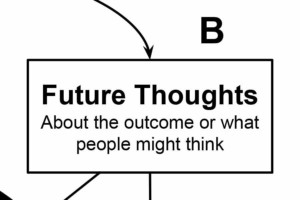
Once our thoughts are in the future, this starts to cause nervousness because the future is an uncontrollable factor. The present moment is what’s controllable. The present certainly affects the future, but the future is technically uncontrollable. Focusing on the future gets us to point C where fear, anxiety, and stress kick in.
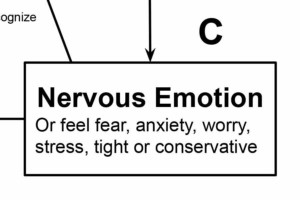
Once a person is feeling stressed, this increases the likelihood of poor decisions and errors, even on tasks that are ordinarily simple. After starting to make a few mistakes due to nervousness, we tend to focus on them. Now, we’re at point D – past thoughts (a mistake from a few seconds ago).
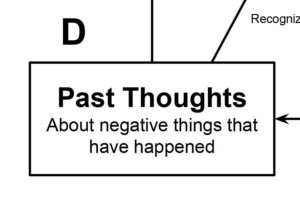
After making a few silly mistakes, athletes often start to get frustrated because they’re “choking” on something that’s so simple in practice. This often leads to point E – anger.
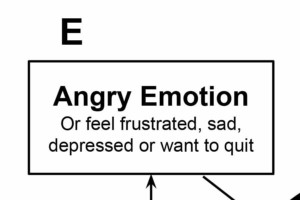
Needless to say, getting angry during an important situation isn’t a recipe for success. So how do we prevent all this and get into the inside ring of the Emotion WheelⓇ where the zone lies?
This is where we apply some of the mental skills we learned earlier in this guide. Remember the GAP exercise? We said it’s THE KEY to getting in the zone. This is where you’ll use it.
Using the GAP exercise to become present
The GAP exercise allows you to break out of the outside ring and “unlock” the inside ring. Without it, you can’t get into the inside ring. The concept is actually fairly simple (although it will probably take some practice to master). Here’s what to do:
As a quick refresher, the GAP exercise is a simple form of meditation that allows us to recognize current thoughts, or become mindful. By doing the GAP exercise as a part of the 3-CoreⓇ routine daily, it’ll become easier to become aware of your thoughts.
The reason people get stuck on the outside ring of the Emotion WheelⓇ is because they’re not consciously aware of their thoughts. And if you’re not aware, how can you fix the problem?
Once you’ve practiced the GAP exercise and are able to recognize thoughts, try it in practice. Next time you start to feel any of the feelings on the outside ring (future thoughts, past thoughts, anxiety or anger), try to recognize the thought.
Just like in the GAP exercise, say “got it” when you realize you’re having this thought. Admit to yourself that, for example, you’re getting frustrated about something that’s now in the past.
Now, you’ve unlocked the middle ring. You’re aware of your thoughts (which were about to negatively impact you), and you’re in control. We call this being “present.” You’re focused on the present moment (not the past or future), and you can control the present. You can control your thoughts right now and therefore your actions right now. These things will lead to a better outcome (future).
Now, it’s time to break down the inside ring.
The Inside Ring
Once you’re present, you’ve just entered the inside ring – this is where the zone lies:
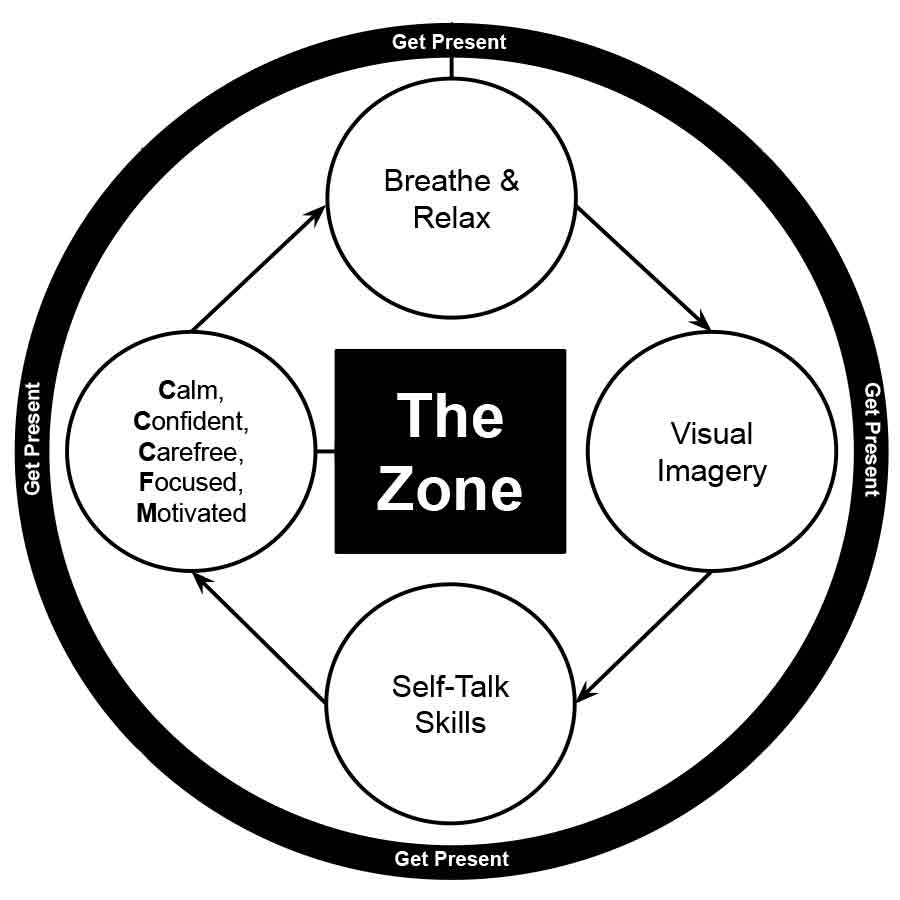
HOWEVER, you’re not in the zone…yet. You’ve “unlocked” the door that was previously blocking you from getting there, but there are still some steps you have to take to get into the zone.
Let’s break those steps down:
You’ll see 4 circles. Start at the top circle: Breathe and relax.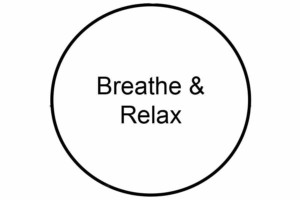
Once you’re present – let’s say you’ve recognized some frustration – breathe and relax. It’s similar to the progressive relaxation exercise we went over earlier (part of the 3-CoreⓇ). This helps you calm down.
Now that you’ve become present and taken a second to relax, use imagery to imagine a perfect execution of the action you need to take next.

This is essentially the visualization exercise from 3-CoreⓇ. Imagine it in the first person – the feeling, the sound, even the crowd cheering, etc. This helps you focus on controllables, become more motivated, improve confidence, and stay focused.
Next is self talk skills.

The “as long as I” statement is a perfect example:
As long as I A, B and C, I know I’m doing everything I can in the moment, and the outcome will be what it is.
Using this statement keeps you in the present and focused on things you can control. It also helps you become carefree, or not worried about the outcome or the score (which you can’t control anyways).
Now that you’ve gone through the inside ring, you should be experiencing the following 5 states of mind:
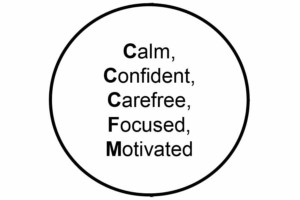
-
- Calm (from breathing and relaxing)
- Confident (from imagery and self-talk)
- Carefree (from self-talk)
- Focused (from imagery and self-talk)
- Motivated (from imagery and self-talk)
Do these states of mind look familiar? That’s right – they’re the Zone-5™ states.
By going through the Emotion WheelⓇ, you’re going through the process of unlocking the inside ring, and getting high Zone-5™, or in the zone.

Here’s the entire emotion wheel again so you can retrace the path to getting in the zone:

Now that you’re in the zone, you’re ready to destroy anything that crosses your path (like Godzilla here):

The “Lightswitch” Effect
Earlier in this article we mentioned a lightswitch effect.
We discussed several different mental skills and pieced it all together using the Emotion WheelⓇ to show you how to get in the zone intentionally. While extraordinarily useful, that process can take several minutes to accomplish (or even longer if you’re brand new to it).
With practice, it’s possible to reduce the amount of time it takes to get in the zone to the point where it’s almost immediate (like flipping a switch). In order to accomplish this, you’ll need to do a few things.
First of all, it’s important to get into a REGULAR ROUTINE of mental skills training. Similar to physical training or working out, you won’t become a master on the first day. It takes regular practice to deepen your mental skills understanding and abilities.
Once you’ve gotten the hang of things, there are a couple key mental skills that are so powerful they can help you move into a high Zone-5™ state very quickly (when correctly customized to your needs). They are:
- The As Long As I statement
- Cue Words
Once you’re in a mental training routine and have a good understanding of the fundamentals, using one of these two skills is a quick way to “flip the lightswitch” and quickly get high Zone-5™ in a pressure situation.
NEXT STEPS: HOW TO APPLY EVERYTHING AND BECOME MENTALLY TOUGH
PHEW! – that was a lot of information.
Now it’s time to put it into ACTION.
In order to do that, you have to first make a decision:
What do you want?
- To stay at the level you’re at right now,
- Or to LEVEL UP above and beyond your current skills (and the competition), and become the greatest version of yourself?
Every great athlete (or great person, for that matter) goes through this decision. Take a look at what tennis legend Roger Federer decided:
So what did you decide?
If you want to level up and become great, follow the steps below very closely.
STEP 1: Save this Guide
We’ve been doing mental training for 25 years. It’s not possible to put everything we’ve learned about becoming mentally tough into ONE article, but this guide provides the fundamentals to get you started (we know, it’s a lot).
The SIMPLEST STEP you can take towards improving mental toughness would be saving this guide for reference. It’s free, it’s easy, and it’s a no brainer. This way, you can quickly refer back to the skills and techniques we’ve discussed as you work to improve mental toughness.
To make life easy, we’ve already created a PDF version for you because it’s easier than bookmarking this page and coming back to it over and over. Just tell us where to send it:
Yes – Send me the PDF!
(we promise not to spam you or sell your email address – we hate that too)
STEP 2: Try-it-yourself
You can learn the basic mental skills by simply saving this guide and studying and practicing mental skills yourself.
Give the 3-CoreⓇ a try. Try using some of the self-talk skills in your daily life. When you start to feel more comfortable, see if you can get into the inside of the Emotion WheelⓇ during a practice session (triggering the zone intentionally).
Top athletes around the world practice mental skills DAILY because they know that’s what’s required to be able to control states of mind, especially in high pressure situations.
This can be hard hard to do on your own, especially when it comes to tracking any of it. That’s exactly why we created MentalAppⓇ – an app designed to help you learn and track mental skills.
STEP 3: Use MentalAppⓇ
MentalAppⓇ is an app we created to help you learn and track mental skills progress. It’s the most complete mobile mental training app in existence, and it’s designed specifically to help athletes and performers develop mental toughness.
MentalAppⓇ comes with a series of training videos that dive much deeper into topics like the ones we’ve discussed in this guide. It’s a comprehensive guide with everything you need to know to improve your mental skills, and therefore accomplish your biggest dreams.
And that’s not even the best part. Beyond just training, it comes with all the tools you need to set up and track performance (both mental and physical) to make sure you’re on track to reach your goals. In short, it’s a MUST HAVE for athletes going the do-it-yourself route. Check it out:
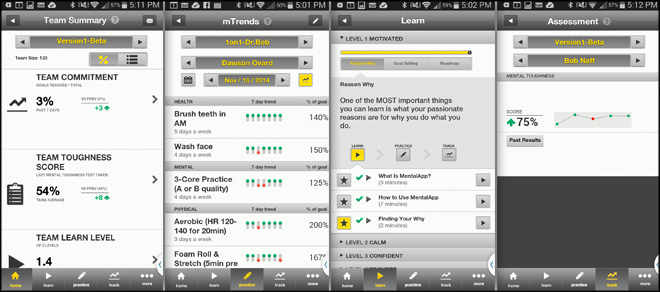
STEP 4: Get Help from a Certified Mental TrainerⓇ
We’re able to deliver SIGNIFICANTLY more value in MentalAppⓇ than we are in this article, but at the end of the day you’re still out there trying to do everything on your own. To get the absolute MOST out of your athletic or performance career without wasting precious golden years trying to figure things on your own, we highly recommend working with a Certified Mental TrainerⓇ.
Our coaches work with you, leveraging MentalAppⓇ, to CUSTOMIZE a program that’s perfectly fit for you and your athletic needs. Our team of expert mental trainers (who are also expert listeners!) has been working with top performers for 25 years, and know EXACTLY how to get an athlete or performer on track to reach their goals. Working with a Certified Mental TrainerⓇ is like skipping to the front of the line that all your opponents stand in as they get stuck trying to figure everything out on their own.
Working with a coach gets you laser-targeted advice from the best in the mental training business. We work with you to set up and align yourself with long-term and short-term goals, then properly track daily steps you need to take to get there. We also help you customize cue words and other triggers that work PERSONALLY for you and your sport/discipline.
The best part of working with a coach is you have an expert by your side when questions and roadblocks come up. Sometimes, challenges come up that leave athletes feeling completely hopeless and ready to give up. With the guidance of a Certified Mental TrainerⓇ, you’ll be able to talk through and overcome roadblocks that may otherwise seem impossible.
We offer 1-on-1 training as well as group training depending on the individual’s needs. Either way, hop on the phone and tell us about your goals so we can help you determine what’s the best fit for you. It’s a free meeting, so there’s no risk in getting advice from an expert Mental Trainer®.
If you’re a parent or a coach and you’re interested in signing up a child athlete for a mental training program, we’re happy to help with that too. Whatever the case may be, our goal is to help turn dreams into reality.
MTI’s core purpose is to help people find the skills they need to be unstoppable, to be free and to be unlimited. To give people the tools to unlock their pure potential and become exceptional on demand.
That’s why we’ve shared this guide with you for free. The information we’ve provided you is gold. But only if you use it. So take the skills and tools we’ve shared and run with them. Learn, practice and master them. It won’t be easy but you can do this. And if you want our support, just ask.
Bottom line? Good intentions are only a start – consistent action is what you need now!
SEO & writing by Mike at Primitive Spark

